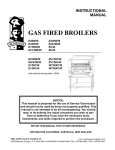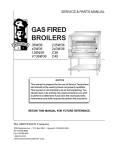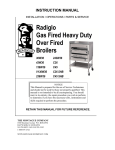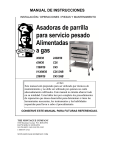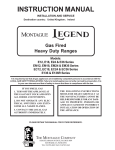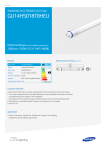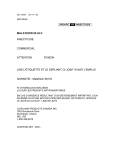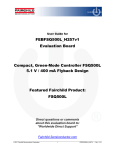Download MONTAGUE 36W36 Specifications
Transcript
INSTALLATION & OPERATION MANUAL GAS FIRED BROILERS E36W36 E43W36 E136W36 D C E E S I GN EV136W36 E236W36 E243W36 EC36 EC45 THE MONTAGUE CO. R T IF I E D Please read this manual completely before attempting to install or operate this equipment! Notify carrier of damage. Inspect all components immediately. See page 4. RETAIN THIS MANUAL FOR FUTURE REFERENCE. The MONTAGUE Company 1830 Stearman Ave. • P.O. Box 4954 • Hayward, CA 94540-4954 • Tel: 510/785-8822 • Fax: 510/785-3342 IMPORTANT FOR YOUR SAFETY THE INSTALLATION INSTRUCTIONS CONTAINED HEREIN ARE FOR THE USE OF QUALIFIED INSTALLATION AND SERVICE PERSONNEL ONLY. INSTALLATION OR SERVICE BY OTHER THAN QUALIFIED PERSONNEL MAY RESULT IN DAMAGE TO THE UNIT AND/OR INJURY TO THE OPERATOR. IF YOU SMELL GAS 1. TURN OFF THE APPLIANCE AT THE GAS INLET COCK AND OPEN ALL DOORS AND WINDOWS. 2. DO NOT OPERATE ANY ELECTRICAL SWITCHES AND EXTINGUISH ALL NAKED FLAMES. 3. CONTACT THE LOCAL GAS AUTHORITY IMMEDIATELY. THE FOLLOWING INSTRUCTIONS SHOULD BE READ CAREFULLY AS THE MANUFACTURER CANNOT BE HELD RESPONSIBLE FOR ANY DAMAGE TO PROPERTY, PERSONS OR ANIMALS CAUSED BY INCORRECT INSTALLATION OR OPERATION OF THE APPLIANCE. POST IN A PROMINENT LOCATION THE INSTRUCTIONS TO BE FOLLOWED IN THE EVENT THE SMELL OF GAS IS DETECTED. THIS INFORMATION CAN BE OBTAINED FROM THE LOCAL GAS SUPPLIER. IN THE EVENT OF A POWER FAILURE, DO NOT ATTEMPT TO OPERATE THIS DEVICE. IMPORTANT IN THE EVENT A GAS ODOR IS DETECTED, SHUT DOWN UNITS AT MAIN SHUTOFF VALVE AND CONTACT THE LOCAL GAS COMPANY OR GAS SUPPLIER FOR SERVICE. FOR YOUR SAFETY DO NOT STORE OR USE GASOLINE OR OTHER FLAMMABLE VAPORS OR LIQUIDS IN THE VICINITY OF THIS OR ANY OTHER APPLIANCE. Improper installation, adjustment, alteration, service or maintenance can cause property damage, injury or death. Read the INSTALLATION, OPERATING AND MAINTENANCE INSTRUCTIONS thoroughly before installing, servicing or operating this equipment. SAVE THESE INSTRUCTIONS FOR FUTURE USE. I&O-2 The MONTAGUE Company TABLE OF CONTENTS IMPORTANT FOR YOUR SAFETY .................................................................................................................. 2 INTRODUCTION ................................................................................................................................................ 4 GENERAL ................................................................................................................................................... 4 MODELS .................................................................................................................................................... 4 DATA PLATE LOCATION ........................................................................................................................... 4 SERIAL NUMBER LOCATION ................................................................................................................... 4 RECEIVING AND INSPECTING THE EQUIPMENT ................................................................................... 4 SPECIFICATIONS ...................................................................................................................................... 5 INSTALLATION ................................................................................................................................................. 6 STATUTORY REGULATIONS .......................................................................................................................... 6 CLEARANCES ........................................................................................................................................... 6 VENTILATING HOOD ................................................................................................................................. 6 VENTILATION AIR ...................................................................................................................................... 6 ASSEMBLY ................................................................................................................................................ 6 Legs...................................................................................................................................................... 6 Ceramic Radiants ................................................................................................................................ 7 LOCATION .................................................................................................................................................. 7 SITING ........................................................................................................................................................ 7 BATTERY ARRANGEMENT ...................................................................................................................... 7 Setting In Place ................................................................................................................................... 7 Floor Mounted Ranges ......................................................................................................................... 8 GAS SUPPLY ............................................................................................................................................ 8 GAS CONNECTION .................................................................................................................................... 8 GAS PRESSURE REGULATOR ................................................................................................................ 9 Adjustment Procedure ....................................................................................................................... 10 PILOT INITIAL ADJUSTMENT .................................................................................................................. 11 BURNER ADJUSTMENT .......................................................................................................................... 11 OPERATION ................................................................................................................................................... 12 GENERAL ................................................................................................................................................. 12 OPERATING CONTROLS ........................................................................................................................ 12 Gas Control ........................................................................................................................................ 12 Lighting/Relighting Pilot and Main Burner .................................................................................. 12 Shutdown ..................................................................................................................................... 13 Grid Height Adjustment ..................................................................................................................... 13 GENERAL MAINTENANCE ............................................................................................................................ 14 GENERAL CLEANING ............................................................................................................................. 14 Daily ................................................................................................................................................... 14 PAINTED SURFACES .............................................................................................................................. 14 Exterior ............................................................................................................................................... 14 Interior ................................................................................................................................................ 14 STAINLESS STEEL SURFACES ............................................................................................................. 14 VENTILATION ........................................................................................................................................... 15 SAFETY.................................................................................................................................................... 15 SERVICING .............................................................................................................................................. 15 C36 & C45 EXPLODED VIEW ........................................................................................................................ 16 C36 & C45 PARTS LIST ................................................................................................................................. 17 36W36 & 43W36 EXPLODED VIEW .............................................................................................................. 18 36W36 & 43W36 PARTS LIST ....................................................................................................................... 19 GAS FIRED BROILERS I&O-3 INTRODUCTION GENERAL The gas broilers covered in this manual are manufactured for use with the type of gas indicated on the nameplate. Some models include a cabinet, conventional oven or convection oven. Ovens are covered in separate manuals. This manual only covers the broiler. Montague gas broilers are produced with the best possible material and workmanship. Proper installation is essential for safe, efficient, trouble-free operation. MODELS MODEL CONSISTS OF E36W36 Cabinet Base Broiler with Warming Oven E43W36 Cabinet Base Broiler with Warming Oven E136W36 Broiler with Conventional Oven and Warming Oven EV136W36 Broiler with Convection Oven E236W36 Double Broiler E243W36 Double Broiler EC36 Broiler Only EC45 Broiler Only DATA PLATE LOCATION The Data Plate is located on the front left of the unit, at the level of the Control Valve panel. SERIAL NUMBER LOCATION Always have the serial number of your unit available when calling for parts or service. The serial number is on the nameplate that also includes the model number. A typical identification plate is shown in Figure 1. MODEL: SERIAL NO.: HEAT INPUT: kW CATEGORY: SUPPLY PRESSURE: mbar GAS: mbar SET PRESS: ELECTRICAL V Hz Ph W COUNTRY: P.I.N.: GAS CATERING EQUIPMENT SALAMANDER - TYPE A THE MONTAGUE COMPANY HAYWARD, CALIFORNIA USA Figure 1. Typical Nameplate RECEIVING AND INSPECTING THE EQUIPMENT Care should be taken during unloading so the equipment is not damaged while being moved into the building. 1. Visually inspect the exterior of the package and skid or container. Any damage should be noted and reported to the delivering carrier immediately. 2. If damaged, open and inspect the contents with the carrier. 3. In the event that the exterior is not damaged, yet upon opening, there is concealed damage to the equipment, notify the carrier. Notification should be made verbally as well as in written form. 4. Request an inspection by the shipping company of the damaged equipment. This should be done within 10 days from receipt of the equipment. 5. Freight carriers can supply the necessary damage forms upon request. 6. Retain all shipping materials until an inspection has been made or waived. I&O-4 The MONTAGUE Company SPECIFICATIONS Table A: Heat Input NO. BURNERS (broiler only) G20 @ 20 mbar kW G31 @ 37 mbar kW TOTAL kW E36W36 2 123,000 ea. 123,000 ea. 24.6 E43W36 3 123,000 ea. 123,000 ea. 36.9 E136W36 2 123,000 ea. 123,000 ea. 36.3 EV136W36 2 123,000 ea. 123,000 ea. 36.3 E236W36 4 123,000 ea. 123,000 ea. 49.2 E243W36 6 123,000 ea. 123,000 ea. 73.8 EC36 2 123,000 ea. 123,000 ea. 24.6 EC45 3 123,000 ea. 123,000 ea. 36.9 MODEL Table B: Setting Pressure/Injector Size Manifold Pressure Orifices G20: 15 mbar Fixed for specified gas type G31: 25 mbar G20: mm (#32 DMS) G30: 25 mbar G31: mm (#47 DMS) Gas Inlet Size: 3/4" NPT at lower left rear (all models) NOTE: The pressure must be measured at the pressure test nipple located on the manifold pipe with the burner lit. Table C: Aeration Shutter/Pilot Flame Settings G30 @ 30 mbar G31 @ 37 mbar mm mm mm PILOT FLAME LENGTH mm E36W36 25 32 32 12.5 E43W36 25 32 32 12.5 E136W36 25 32 32 12.5 EV136W36 25 32 32 12.5 E236W36 25 32 32 12.5 E243W36 25 32 32 12.5 EC36 25 32 32 12.5 EC45 25 32 32 12.5 MODEL 2nd FAMILY, GROUP H G20 @ 20 mbar GAS FIRED BROILERS 3rd FAMILY, GROUP 3+ I&O-5 INSTALLATION CAUTION: Provision must be made to assure adequate air supply to unit for proper burner operation. STATUTORY REGULATIONS The installation of this appliance must be carried out by a competent person and in accordance with the relevant regulations, standards, codes of practice and the related publications of the country of destination. CLEARANCES The following are minimum clearances from combustible and noncombustible materials. Location Combustible Construction Noncombustible Construction Back Wall 152 mm 0 mm Left Side 152 mm 0 mm Right Side 152 mm 0 mm With 152 mm legs: Suitable for installation on combustible floors. NOTE 1: The room containing the appliance is required to have a permanent air vent. The minimum effective area of the vent is related to the maximum rated heat input of the appliance and shall be 4.5 cm2 per kW in excess of 7 kW. NOTE 2: Air vents should be of such a size to compensate for the effects of any extract fan in the premises. It is also necessary that sufficient room air ingress be allowed to compensate for the amount of air removed by the ventilating system. Otherwise, a subnormal atmospheric pressure will occur which may interfere with burner performance or may extinguish the pilot flame. In case of unsatisfactory broiler performance check with the exhaust fan in the “OFF” position. This appliance is to be installed with sufficient ventilation to prevent the occurance of unacceptable concentrations of substances harmful to health in the room in which it is installed. Without legs: For use with special insulated base on noncombustible floors only. VENTILATING HOOD The broiler(s) must be installed under a properly designed ventilating hood. The hood should extend at least 152 mm beyond all sides of the unit. The hood should be connected to an adequate mechanical exhaust system. VENTALIATION AIR The following notes are intended to give general guidance. For detailed recommendations, refer to the applicable code(s) in the country of destination. I&O-6 ASSEMBLY Uncrate broiler as near to final location as possible. For easier and lighter handling of broiler, remove grids, grid frame, drip tray and grease container. Remove all packing materials and accessories from broiler interior. Legs Some broilers are mounted on legs. 1. Screws the legs into the modular stand. 2. Tightly screw the complete leg assembly into the mounting holes in the bottom of the broiler at each corner. If the unit is intended for curb installation, no legs are provided. The curb must be noncombustible material. The MONTAGUE Company Ceramic Radiants Ceramic radiants, Figure 2, are located on each side of the burners. Ceramic end pieces are installed at both ends of each burner assembly. Five (5) ceramic radiants are installed on each side of each burner with the pointed side facing down and the holes facing up, Figure 3 TOP VIEW Frame 2. Tilt ceramic radiant sideways to clear burner and frame assembly, then lower radiant into position with one flange resting on burner ledge and one flange resting on frame edge. 3. Install the remaining ceramic radiants so that five (5) ceramic radiants are located on each side of the burner. LOCATION Burner Adequate clearance for service and proper operation must be provided at the front, top, sides, and back. The combustion air openings are provided in the front of the unit and must not be obstructed. Ceramic radiants Ceramic ends (5 each side) (4) FRONT VIEW MO10031 SITING The floor on which the range is to be sited must be capable of adequately supporting the weight of the appliance and any ancillary equipment. Once in position check that the unit is level, both front to back and side to side. Adjust if necessary, using the adjusting foot on each leg. Figure 2. Ceramic Radiants Positioning BATTERY ARRANGEMENT Carefully remove range from crate. Burner tie wires and other packing material must be removed from the unit. On stainless steel units, the protective material covering the stainless steel must be removed immediately after unit is installed. Setting In Place Model Nos. E36W36, E43W36, E136W36 and EV136W36. MO10032 Figure 3. Ceramic Radiants 1. Insert ceramic end pieces at front and rear of the burner frame. Four (4) are required for each burner. GAS FIRED BROILERS I&O-7 Floor Mounted Ranges 1. Place the first unit in the exact position it will occupy in the battery. 2. Using a carpenter’s level, level the unit frontto-rear and side-to-side. AN UNLEVELED UNIT WILL ADVERSELY AFFECT PEFORMANCE. Adjust as follows: FLOOR INSTALLATION ON LEGS: Level by turning foot on leg. CURB INSTALLATION: Place shim under the low side. This operation is important since variations in floors and curbs are common. Unless units are level, aligning the gas supply manifold will be difficult and the units will not fit together tightly. 3. Remove the valve panel from the broiler. 4. Move the next unit into position. 5. Engage union nut on manifold with male fitting on next unit and draw up union nut hand tight. Be sure appliances meet together both front and rear. If manifolds do not align, then units are not level. In extreme cases, it may be necessary to loosen manifold bolts and adjust. 6. Continue leveling and connecting gas supply manifolds together until all appliances in battery are connected. 7. Tighten manifold gas union. Use backup wrench to prevent manifold from rotating. FAILURE TO DO THIS MAY RESULT IN DAMAGE TO THE PILOTS AND GAS VALVES. GAS SUPPLY The local gas region should be consulted at the installation planning stage in order to establish the availability of an adequate supply of gas and to ensure that the meter is adequate for the required flow rate. The pipe work from the meter to the appliances must be of appropriate size. Where a number of appliances are installed in a battery, no more than five should be served by any one supply pipe. All fixed (non-mobile) appliances MUST be fitted with a manual gas cock upstream of the I&O-8 appliance to provide a means of isolation for servicing or cleaning. A union or similar means of disconnection must be provided between the gas cock and the appliance. A manually operable valve must be fitted to the gas supply to the kitchen to enable it to be isolated in an emergency. Wherever practical, this shall be located either outside the kitchen or near an exit in a readily accessible position. Where it is not practical to do this, an automatic isolation valve system shall be fitted which can be operated from a readily accessible position near the exit. At locations where the manual isolation valve is fitted or the automatic system can be reset, a notice MUST be fitted stating: “ALL DOWNSTREAM BURNER AND PILOT VALVES MUST BE TURNED OFF PRIOR TO ATTEMPTING TO RESTORE THE SUPPLY. AFTER EXTENDED SHUT OFF, PURGE BEFORE RESTORING GAS.” GAS CONNECTION Before connecting the broiler(s) to the gas supply line, be sure that all new piping has been cleaned and purged to prevent any foreign matter from being carried into the controls by the gas. In some cases, filters or drops are recommended. A separate gas shutoff valve must be installed upstream from the gas pressure regulator adjacent to the broiler and located in an accessible area. It is important that adequately sized piping be run directly to the point of connection at the broiler with as few elbows and tees as possible. Consult your local gas company for proper piping size and gas pressure. The size of the pipe work supplying the appliance must not be less than the inlet connection. Each broiler has a 3/4" NPT manifold input located at the lower left rear of the broiler, Figure 4. On dual broilers, each broiler must have a separate regulator. NOTE: Pipe joint compound or thread sealant that is used should be resistant to action of liquefied petroleum gases. The MONTAGUE Company 3/4" NPT Gas inlet MO10033 Figure 4. Gas Inlet Install the gas pressure regulator with gas flowing as indicated by the arrow on the regulator. The arrow must be pointing in toward the unit. Use pipe compound or thread sealant and carefully thread regulator to pipe so that there is no cross threading, etc., which could cause leakage. 1. Apply wrench only to the flat areas around the pipe tapping at the end being threaded to the pipe to avoid possible damage to the regulator body which could result in leakage. 2. Connect the gas supply line from the service gas shutoff valve to the inlet side of the gas pressure regulator using 3/4" pipe. Avoid kinks or sharp bends that could restrict gas flow. NOTE: If flexible or semi-flexible connectors are used, a CE listed flexible connector with an I.D. equal to 3/4" pipe must be used. Do not use a domestic type flexible gas connector. 3. Turn gas shutoff valve on and carefully check for gas leaks immediately. Do this before attempting to operate the broiler. Test all pipe joints for leaks before operating broiler. This includes all gas connections that may have loosened during shipment. Use a rich soap solution (or other accepted leak tester) around all pipe connections and all other joints. Do not use an open flame. Absolutely no leakage should occur, otherwise there is a danger of fire or explosion depending upon conditions. Do not use unit if leakage is detected. After piping has been checked for leaks, all piping receiving gas should be fully purged to remove air. GAS PRESSURE REGULATOR The broiler(s) is/are designed for use with a gas pressure regulator. The regulator(s) supplied with this unit must be used. FOR G20 GAS: This gas pressure regulator is factory adjusted for 15 mbar manifold pressure. The rated inlet pressure to the regulator is 3.45 kPa. FOR G31 and G30 GAS: This gas pressure regulator is factory adjusted for 25 mbar manifold pressure. The rated inlet pressure to the regulator is 3.45 kPa. The broiler is equipped with fixed orifices for use with a manifold pressure of 15 mbar for G20 gas and 25 mbar for G31 and G30 gas. Position the gas pressure regulator outside the broiler as near to the unit as possible. CAUTION: The gas pressure regulator must be located out of the heat zone to prevent damage to the regulator. The whole of the gas installation, including the meter, should be inspected, purged and tested for soundness in accordance with the codes of the country of destination. GAS FIRED BROILERS I&O-9 Adjustment Procedure Do not allow untrained personnel to maintain or service the gas pressure regulator. 1. Before adjusting the regulator, check the incoming gas line pressure into the regulator. Incoming pressure must be 20 mbar for G20 gas, 37 mbar for G31 gas, or 30 mbar for G30 gas. 2. If incoming pressure is not correct, have the gas source checked and adjusted. 6. Connect a manometer to the pressure tap provided on the broiler unit gas piping manifold, Figure 6. Turn all gas taps to the full on “O” position. 7. Check the manometer reading. The reading must be 15 mbar for G20 gas, 25 mbar for G31 gas, or 25 mbar for G30 gas, per Table B on PAGE 5. 8. If incoming line pressure is not correct, adjust the regulator. Remove the seal cap on the top of the regulator. 9. Insert a blade-type screwdriver into the top hole of the regulator. 3. Make sure that the regulator is mounted in the horizontal position with the arrow pointing in the direction of the gas flow. SEE PAGE 12, LIGHTING /RELIGHTING PILOT AND BURNER. 10. Turn the adjustment screw clockwise to increase the pressure, or counter clockwise to decrease the pressure. 4. Remove the main burner control valve knobs, Figure 5. While watching the manometer, turn the adjustment screw to set proper regulator outlet pressure to the manifold. D C E D C E E S I GN E S I GN THE MONTAGUE CO. R T IF I E D THE MONTAGUE CO. R T I FI E D Burner valve knobs Manifold Screws MO10034 Manometer connection pressure tap MO10035 Figure 6. Gas Pressure Tap Figure 5. Control Valve Knobs 5. Remove the control valve panel by removing two screws. I&O-10 The MONTAGUE Company PILOT INITIAL ADJUSTMENT Each burner has a separate pilot burner. The pilot flame is not adjustable. Pilot access is through the broiler opening. 1. Turn the main gas shutoff valve to the on position. 2. Light each pilot. 3. Ensure that each pilot burner has a steady blue flame, Figure 7, per Table C on PAGE 5. The pilot flame should envelope the tip of the thermocouple. The pilot flame can be viewed up through the opening of the broiler compartment. 1. Lift off the venturi cover to access the air shutter for each main burner. 2. Turn on the main burner control valve for the main burner to be adjusted by rotating the main burner control valve fully counterclockwise to the “O” position. 3. Increase the air shutter openings until the flame on the burner begins to “lift”. Then close shutter until flame no longer floats, and lock in place. A yellow streaming flame indicates insufficient air. Correct this condition by increasing air shutter opening. The correct setting is shown in Table C on PAGE 5. Air shutters Figure 7. Pilot Burner E S I GN THE MONTAGUE CO. C D D E R T IF I E Replace the control valve panel and the main burner control valve handles. BURNER ADJUSTMENT The efficiency of the broiler depends on a delicate balance between the supply of air and the volume of gas at each main burner resulting in complete combustion. Whenever this balance is disturbed, poor operating characteristics occur. An air shutter, Figure 8, on the front of each main burner controls the air supply. NOTE: Pilots should be lit, SEE PAGE 12, before adjusting the main burners. GAS FIRED BROILERS Main burner control valves Control valve panel MO10038 Figure 8. Main Burner Air Shutter 4. After all main burners are properly adjusted, reinstall the venturi cover. 5. Turn all main burner control valves fully clockwise to the “O” position to turn the main burner off. I&O-11 OPERATION GENERAL This appliance has been classified as commercial cooking equipment and must be operated by qualified and/or professional operating personnel. The broiler and its parts are hot. Use care when operating, cleaning or servicing the unit. CAUTION: Do not obstruct the flow of combustion and ventilation air to the broiler. Keep appliance area free and clear of combustibles. BURNER CONTROL: Used to turn the main burner and pilot gas on or off. One control for each burner. GRID HEIGHT: The grid is set to the desired cooking height by depressing the ball and adjusting lever up or down. Gas Control Lighting/Relighting Pilot and Main Burner 1. Turn burner valve handle to off position and wait five (5) minutes. 2. Push in the tap and turn it counter-clockwise ”. to the ignition position “ 3. Holding the tap fully in, light the pilot with a match or taper. OPERATING CONTROLS In the event gas oder is detected, shut down units at main gas shutoff valve and contact the local gas company or gas supplier for service. The following controls are used for operation of the broiler, Figure 9. 4. When the pilot is lit, continue to hold the tap fully in for 20 seconds, then release it. If the pilot goes out, wait for (5) minutes, then repeat from step 1. 5. When the pilot is established, push the tap in again and turn it counter-clockwise to the full flame position “ ”, thus lighting the main burner. IMPORTANT: DO NOT THROTTLE THE BURNER DOWN. BURNER MUST OPERATE FULLY OPEN AT ALL TIMES. E S I GN THE MONTAGUE CO. C D D E 6. If pilot becomes extinguished, turn main burner valve to the off position (fully counterclockwise) and wait five (5) minutes before relighting. R T I FI E Burner valve knobs Grid height control MO10039 Figure 9. Operating Controls I&O-12 The MONTAGUE Company Shutdown 1. Standby: To turn off, rotate main burner valve handles clockwise to the ignition ”. position “ 2. Complete: To shut the burner and pilot off, turn the dial to the “ ” symbol and the safety device will disengage within 60 seconds. IMPORTANT: NEVER THROTTLE THE BURNER DOWN. OPERATE BURNER IN FULL ON POSITION. PREHEAT TIME - Allow at least 5 minutes after turning the broiler on from cold, before loading the broiler with food to be cooked Check the grease container and drain frequently during heavy use to prevent overflow. Grid Height Adjustment Depress black ball and move lever up or down to desired cooking height, Figure 9. GAS FIRED BROILERS I&O-13 GENERAL MAINTENANCE GENERAL CLEANING PAINTED SURFACES The broiler and its parts are hot. Use care when operating, cleaning or servicing the unit. Lint and grease suspended in the air tend to collect in passages. Therefore, air openings, flue ways, and primary air openings, etc., should be periodically cleaned to prevent clogging. The entire broiler should be given a periodic general cleaning. Allow the broiler to cool down before cleaning exterior surfaces. Painted surfaces should be cleaned using a mild soap and warm water solution on a sponge or soft cloth. Interior Clean interior using a mildly abrasive cleanser with a damp cloth or nylon cleaning pad. Daily Remove grid racks, drip deflector (below grid rack), drip tray, and grease container. Thoroughly wash with mild detergent or soap. Excessive grease buildup may be removed by using a mildly abrasive cleanser. Grid rack Grease container Drip tray STAINLESS STEEL SURFACES To remove dirt, grease or product residue from stainless steel, use ordinary soap and water (with or without detergent) applied with a sponge or cloth. Dry thoroughly with a clean cloth. To remove grease and food splatter, or condensed vapors that have baked on the equipment, apply cleanser to a damp cloth or sponge and rub cleanser on the metal in the direction of the polishing lines on the metal. Rubbing cleanser as gently as possible in the direction of the polished lines will not mar the finish of the stainless steel. NEVER RUB WITH A CIRCULAR MOTION. Drip deflector MO10040 Figure 11. Items To Be Cleaned Daily I&O-14 Exterior Soil and burnt deposits which do not respond to the above procedure can usually be removed by rubbing the surface with SCOTCH-BRITE scouring pads or STAINLESS scouring pads. DO NOT USE ORDINARY STEEL WOOL as any particles left on the surface will rust and further spoil the appearance of the finish. NEVER USE A WIRE BRUSH, STEEL SCOURING PADS (EXCEPT STAINLESS), SCRAPER, FILE OR OTHER STEEL TOOLS. Surfaces which are marred collect dirt more rapidly and become more difficult to clean. Marring also increases the possibility of corrosive attack. The MONTAGUE Company To remove heat tint: Darkened areas sometimes appear on stainless steel surfaces where the area has been subjected to excessive heat. These darkened areas are caused by thickening of the protective surface of the stainless steel and are not harmful. Heat tint can normally be removed by the procedures described above. Heat tint which does not respond to this procedure calls for a vigorous scouring in the direction of the polish lines, using SCOTCH-BRITE scouring pads or a STAINLESS scouring pad in combination with a powdered cleanser. Heat tint action may be lessened by not applying or by reducing heat to equipment during slack periods. VENTILATION The area in which the appliance is installed must be adequately ventilated to provide air for combustion, removal of products of combustion and removal of steam, etc. The use of a mechanical extract system should be considered. SERVICING If not installed, operated and maintained in accordance with the manufacturer’s instructions, this product could expose you to substances in fuel or in fuel combustion which can cause death or serious illness and which are known to the State of California to cause cancer, birth defects or other reproductive harm. All personnel in the workplace who may be subject to any exposure of carbon monoxide must be warned of such possible exposure. This warning should be conveyed in a manner so that it is clearly understood by the employee, and the employee should be asked if in fact he or she understands the correct method of operation of the equipment and that a risk of exposure exists if the equipment is operated improperly. To ensure efficient and safe operation of the appliance it is recommended that servicing is carried out at regular intervals, the frequency of which will vary depending on the installation conditions and usage (usually once per year is adequate). Servicing must be carried out by competent persons in accordance with the law. SAFETY It is essential that the instructions in this booklet are strictly followed for the safe and economical operation of the equipment. If it is known or suspected that a fault exists on the appliance, then it must not be used until the fault has been rectified by a competent person. GAS FIRED BROILERS I&O-15 C36 & C45 EXPLODED VIEW 7 8 6 5 4 3 2 1 I&O-16 The MONTAGUE Company ITEM PART NUMBERS DESCRIPTION C36 236W36 C45 243W36 1 2033-8 2033-8 KNOB, BLACK BALL 2 3504-1 3504-1 HANDLE, SLEEVE 3 1600-4 1600-4 GRID IRON, RIGHT 4 N/A 1602-0 GRID IRON, CENTER 5 1601-2 1601-2 GRID IRON, LEFT 6 2002-8 2002-8 HANDLE, VALVE, W/SET SCREW 7 11611-4 11611-4 CERAMIC, LARGE 7A 28387-8 28387-8 CERAMIC KIT (10 ea. 11611-4 Large Ceramics; 4 ea. 11614-9 Ceramic insulators) 8 11614-9 GAS FIRED BROILERS 11614-9 INSULATOR, CERAMIC I&O-17 36W36 & 43W36 EXPLODED VIEW 7 8 9 10 6 5 4 3 2 1 I&O-18 The MONTAGUE Company ITEM PART NUMBERS DESCRIPTION 36W36 43W36 1 2033-8 2033-8 KNOB, BLACK BALL 2 3504-1 3504-1 SLEEVE 3 1601-2 1601-2 GRID IRON - RIGHT 4 N/A 1602-0 GRID IRON- CENTER 5 1601-2 1601-2 GRID IRON - LEFT 6 2002-8 2002-8 HANDLE, VALVE, W/SET SCREW 7 11611-4 11611-4 CERAMIC, LARGE 7A 28387-8 28387-8 CERAMIC KIT (10 ea. 11611-4 Large Ceramics; 4 ea. 11614-9 Ceramic insulators) 8 11614-9 11614-9 CERAMIC INSULATOR 9 3173-9 3173-9 HANDLE 10 1604-7 1579-2 WIRE RACK GAS FIRED BROILERS I&O-19 The MONTAGUE Company 1830 Stearman Ave. • P.O. Box 4954 • Hayward, CA 94540-4954 Tel: 510/785-8822 • Fax: 510/785-3342 I&O-20 The MONTAGUE Company P/N: 42880-9 (5/08)




















